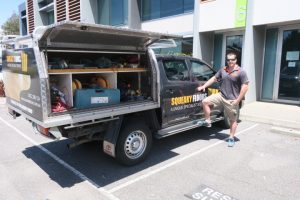Breaking the silence on squeaky floors
Protection from the elements is the key to preventing noise pollution in new residential properties. Brihony Tulloch investigates how you can help.

Squeaky floors can plague both new and old homes alike. Fixing noise pollution issues can be intimidating since finding the cause requires a fair amount of diagnostic work (which not too many builders have the patience for). But did you know squeaky floors can be prevented by simply implementing strict weather protection policies onsite?
Scott Stephens owns and operates Squeaky Floors, a specialist service that provides general carpentry as well as noise pollution solutions. He understands that fixing vibration or friction issues without damaging carpeting or hardwood flooring can seem daunting even to the most experienced of builders.
“When doing my carpentry course I found that no other builders in the class even knew where to start when it comes to repairing squeaky floors,” he says.
“While scouring a job board website for carpentry work, I noticed that there was a large number of ads from home owners looking for someone to repair noise pollution issues going back six months that no other carpenters were taking on. That’s how the idea for Squeaky Floors was born.”
But you don’t need specialised skills to fix squeaky floors – builders can stop the issue long before home owners hear that irritating creak.
Noise pollution is an issue usually associated with older homes. Floorboards, joints and adhesives succumb to wear and tear over time and inevitably start to squeak, but Scott emphasises that it also occurs in new buildings and homes and therefore should be at the forefront of every builder’s mind.
“Squeaky floors are a problem usually associated with heritage homes, but that’s simply not the case. We can work on properties that are anywhere between 10 to 80 years old,” says Scott.
“Then figuring out the source of noise pollution is like a puzzle; is it the floorboards, is it the soft floor, is it the sealant underneath?
“There are many causes of squeaky floors,” says Scott, but builders taking short cuts and using poor quality materials during the construction of new homes is a large contributor to the problem.
For example, if adhesive glue gets dirty, or the installer waits too long to put the plywood on the glue, the adhesive’s grip can diminish, increasing the likelihood of squeaks. Shonky hammering can leave gaps between the joists and nail which also leads to noise pollution.
But the issue that is almost guaranteed to result in squeaky floors is the framework and sheet flooring being exposed to moisture.
“Water is your number one cause,” warns Scott.
“Once the flooring swells, it breaks that bond with the glue. Nails will hold it for the first four to five years, but after that we usually get a call.
“Time and the elements are the two main causes of noise pollution. More often than not, when new homes are being built, there’s a delay between when the framing is erected and the cladding is put up to enclose and protect the framework leaving it vulnerable to the elements.
“Further, Yellow Tongue sheet flooring, which is most commonly used, has a lifespan in terms of being exposed to the elements, so what we find in a lot of the newer homes is problems occur because the flooring has been exposed to too much water during the building process.”
But Scott acknowledges that implementing stricter weather protection policies can be easier said than done.
“Depending on which state or territory construction takes place, building framework may require an inspection or additional work,” he says.
“This inevitably causes delays, not to mention the time it takes to put the roof and cladding on, so shielding it from the weather is sometimes easier said than done.”
Scott’s number one message to home builders is that prevention and protection is the key.
“The best thing builders can do to prevent future squeaky floors is to protect the framework and sheet flooring from the weather. Once the framing is up, protecting it is critical; get it enclosed and watertight as fast as possible.”
